Presented in the World Congress on Engineering 2013, in London
Study for the protection of an installation of panels PV against the loads owed to the wind
Joaquín Menacho and Andrés To. García Granada.

Fig. 1: The calculations in this study have realizar using Solid Works Flow Simulation, of Dassault.
The purpose of the study is double: on the one hand, it treats to study the effect of the position of each one of the solar panels in the group of the installation regarding the supported load by the effect of the wind; second, it treats of a preliminary study oriented to propose some form of protection against the wind in the installations PV, by means of the installation of a protective signpost situated in the steering of the dominant winds. For this has resorted to a methodology of ‘virtual experimentation, by means of a software of calculation CFD, on a concrete model.
Model used
The model studied is composed by a matrix of 5 x 5 solar followers, on a flat surface. The panels are of 7 x 4.5 m, with an elevation of 45º. The height of the centre of the panels is of 2 m (Fig. 2). The protection proposed consists in a plate of 40 m of length, with an inclination of 45º: as it can see in the figure, covers entirely the central rows of panels, but only partially the most external rows.
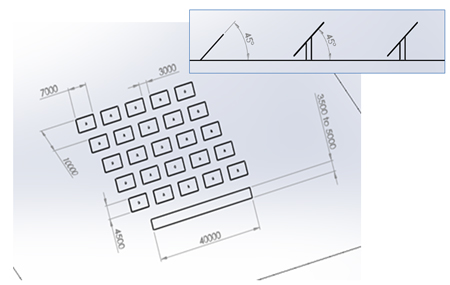
Fig. 2: The matrix of panels PV (dimensions in mm).
The calculations have realizar using Solid Works Flow Simulation, of
Influence of the different positions inside the matrix of panels
The parameters that have taken into account are the position of the signpost in the group, the height of the protective signpost and his distance with regard to the matrix of panels PV. They have studied four different positions, as it indicates in the figure 3. The first position situated in the first place of the most external row, no very covered by the signpost of protection. The position 2 is in the first place of the central row, the nearest position to the signpost of protection. The position 3 is a position centred in the matrix of panels. Finally, the position 4 is in the final corner of the matrix: badly protected by the signpost of protection but protected by the followers situated in front of her.
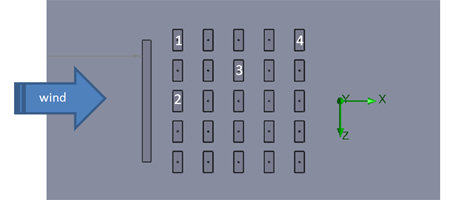
As it can see in the figure 4, a wind of face of 100 km/h represents some very considerable loads on the panels PV. But these loads are very different according to the position that each solar follower occupies inside the field. An inner signpost to the matrix (position 3) bears a moment of cabeceo four lower times that a signpost situated in the front (position 1 and 2).
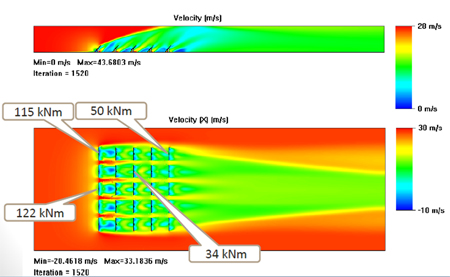
Effect of a signpost of protection
The second aim of the study is to realizar a preliminary estimate of the influence of a protective signpost on the loads owed to the wind. The minimum distance between this signpost and the group of the solar followers depends on his geometry and of the latitude of the installation.
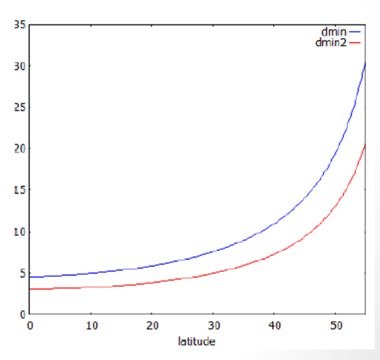
As it can see in the figure 5, for the model studied and a latitude around the 40º, the distance does not have to be very inferior to the 10 m. To this distance of 10 m, a signpost of protection with an elevation of 45º, and with widths from among 3.5 and 5.0 m, the results of the simulations reduce the moment of cabeceo (Z-Torque) to values underneath of 10 kNm (Fig. 6), which means a reduction of 90% with regard to the values calculated without this protection. The width of the signpost of protection does not seem to have a too significant effect on the results, in the margin of values considered.
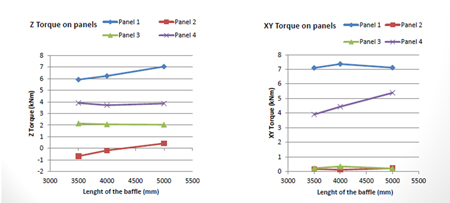
The moments around the axles X and And are very similar, which is reasonable, since they represent two components of a same moment (XY) that exerts surroundings to the perpendicular axis to the surface of the solar panels. This moment is almost invalid for the panels situated in positions very covered, but has a significant value for the positions situated in the most external row of the matrix (1 and 4). This is due to the fact that the only partial protection, beside the external situation, produces an asymmetric distribution of the loads on the signpost, which translates in a moment that tends to do turn the signpost with a movement of ‘guiñada'.
Also has simulated the same case, situating in this occasion the signpost of protection to 15 m of distance. The results obtained indicate that the protection worsens, since the values of the moment of cabeceo reach until 35 kNm for the less protected position (1).
The simulations realizar for a wind of tail of 100 km/h also launch interesting results. Without any protection, the moments calculated on the panels PV in the distinct positions reach the 14 kNm in the positions 1 and 2, that are now the worst positions for being in the start of the trail that leaves the wind. Entering a signpost of protection situated to 10 m of distance of the matrix of solar followers, obtain inferior values to 5 kNm (Fig. 7).
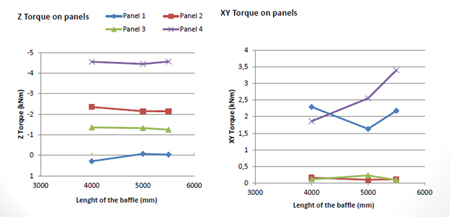
Conclusions and future work
The group of these calculations seems to indicate that the introduction of panels of protection for the solar fields can be an interesting performance to reduce the costs of maintenance of the installations with a relatively low investment. Also it indicates that the efforts exerted on the different positions inside the matrix of panels are important. This could take into account to the hour to design the solar followers for different positions. But for this would have to have resulted more conclusive that those that can give off of this work, that only can consider a preliminary approximation. Still it is missing to contrast the calculations realizar with experimental data, as well as study other configurations to find ways to generalise the results.
References
- Hernández, S., Méndez, J., Grandson, F. and Sworn, JA., (2009) Aerodynamic analysis of to photovoltaic solar tracker, EACWE 5, Florence (It).
- Mohapatra, S., (2011) Wind tunnel investigation of wind praise on to ground mounted photovoltaic tracker, M.sc. Thesis, Colorado State University (Co, USES).
- Pfahl, To., Buselmeier, M. and Zaschke, M., (2011) Wind loads on heliostats and photovoltaic trackers of various aspect ratios, Solar Power 85, 2185–2201.
- Wang, S., Sun, And., Wang Q., Wang Q. and Wei M., (2011) Limit Requirements Simulation of Sundial Solar Tracking Machine, Chinese Journal of Mechanical Engineering.
- Shademan, M. and Hangan, H., (2010) Wind loading on solar panels at different azimuthal and inclination angles, The Fifth International Symposium on Computational Wind Engineering (CWE2010), Chapel Hill (NCa, USES).






